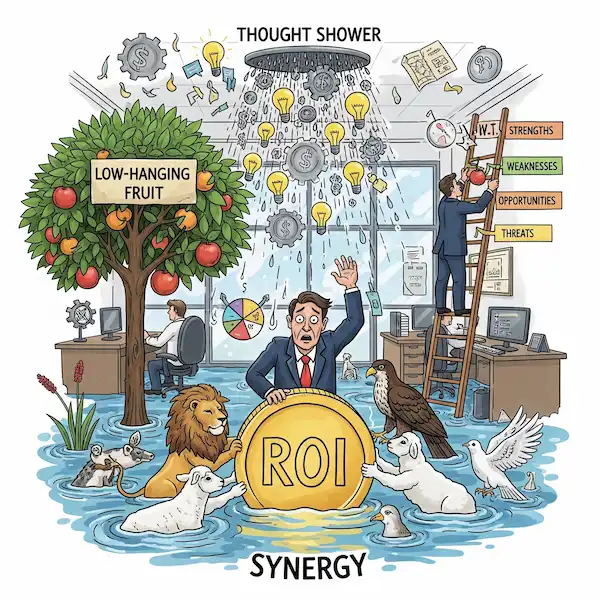Deciphering the Secret Language of Business: A Guide to Business Jargon 💼
Have you ever been in a business meeting or read a professional email and felt like you were listening to a different language? You’re not alone! Business jargon is a specialized vocabulary that professionals use to communicate quickly and efficiently. While it can be confusing at first, understanding these terms is a key step to sounding confident and competent in the workplace.
This article will help you understand the most common business jargon, so you can “get on the same page” with your colleagues and “add value” to any conversation.
📖 Reading: The Top 10 Business Jargon Terms
Let’s “deep dive” into some of the most common terms you’ll encounter. For each one, we’ll provide a definition and an example of how it’s used in a sentence.
- “Action item”: A task that needs to be done.
- Example: “Let’s make sure we have clear action items from today’s meeting.”
- “Bandwidth”: The capacity to handle a task or new work. This is a metaphorical term taken from technology.
- Example: “I don’t have the bandwidth to take on another project this week.”
- “Circle back”: To return to a topic later. It’s a polite way to postpone a discussion.
- Example: “That’s a great point, but let’s circle back to it after we discuss the budget.”
- “Low-hanging fruit”: The easiest tasks or goals to achieve.
- Example: “Before we tackle the big challenges, let’s focus on the low-hanging fruit to show some early success.”
- “On the same page”: To have a shared understanding or agreement with others.
- Example: “Before we start, I just want to make sure everyone is on the same page with the new strategy.”
- “Synergy”: The idea that two or more things working together produce a greater effect than they would alone.
- Example: “The new partnership between our two departments will create a powerful synergy.”
- “Touch base”: To make brief contact with someone, often to get an update.
- Example: “I’ll touch base with you tomorrow to see how the project is going.”
- “Think outside the box”: To think in a creative, unconventional, or innovative way.
- Example: “For this new ad campaign, we need to think outside the box to get people’s attention.”
- “Win-win”: A situation or solution that is beneficial to all parties involved.
- Example: “Offering a discount on our new product is a win-win for both our company and our customers.”
- “Drill down”: To look at something in more detail.
- Example: “The sales numbers look great, but let’s drill down into the data to see which products are performing best.”
📊 Jargon at a Glance: Business Acronyms and Phrases
Business jargon often includes business acronyms and short phrases. Memorizing these will help you understand conversations and written documents.
| Acronym/Phrase | Meaning | Example Sentence |
| ASAP | As soon as possible | “Please send me that report ASAP.” |
| FYI | For your information | “FYI, the meeting has been moved to 3 PM.” |
| KPI | Key Performance Indicator | “One of our main KPIs is customer satisfaction.” |
| ROI | Return on Investment | “We need to calculate the ROI of this campaign.” |
| EOD | End of Day | “Can you have the final numbers to me by EOD?” |
| TBD/TBA | To Be Determined/Announced | “The start date for the new project is still TBD.” |
🗣️ Speaking and Listening: Using Business Jargon in Practice
The best way to master business jargon is to use it. Here’s a simple role-playing exercise you can do with a friend or classmate.
Scenario: You and your colleague are planning a new project.
You: “I think we should start with the easiest tasks first. We can call them the low-hanging fruit.” Your Colleague: “I agree. We can then circle back to the more difficult tasks later. Once we have some initial results, we can calculate the ROI to show management that the project is a win-win.” You: “Exactly. And before we start, let’s make sure we’re all on the same page. We need to get this done ASAP.”
Why this helps (E-A-T): Using these terms correctly shows that you have expertise in professional communication. It makes you sound more authoritative and builds trust with your colleagues because you’re using the same “language.”
Additional Helpful Content: The Double-Edged Sword of Business Jargon
While jargon can be useful, it can also be a barrier.
- When to use it: Use jargon when you’re communicating with people who you know understand the terms. It can make conversations more efficient.
- When to avoid it: Don’t use jargon with people who may not understand it, such as new employees, customers, or people from other departments. In these situations, using simple, clear language is always the best approach.
- A simple trick: If you use a term and see a confused look on someone’s face, immediately explain what you mean in plain English. This shows that you are a helpful and clear communicator.
Additional Links
External Links for Authoritative Sources:
- Investopedia Financial Terms Dictionary: A comprehensive resource for a wide range of business and financial terms: https://www.investopedia.com/financial-terms-dictionary-4769738
- Atlassian Blog: 31 corporate jargon phrases to avoid (and what to say instead): This article provides great examples of jargon and offers alternatives for clearer communication: https://www.atlassian.com/blog/teamwork/6-examples-of-business-jargon-you-should-stop-using-now
- Gale Business Resources: A useful resource for small business research and planning, which includes many business terms: https://www.gale.com/databases/gale-business

